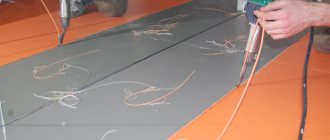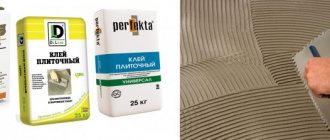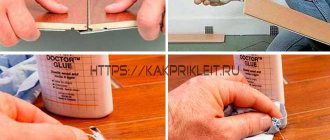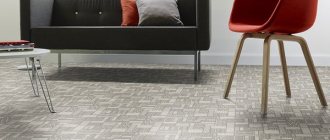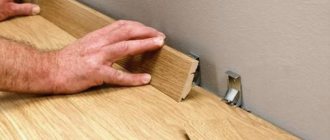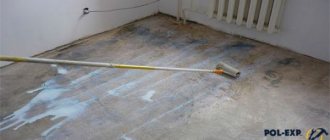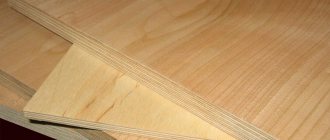When renovating, linoleum is often chosen as a floor covering. This is a modern material that has such qualities as strength, durability, practicality, texture. In addition, its cost is quite low compared to other materials. In order for the coating to please its owners for a long time, it is important not only to choose high-quality material, but also to securely fasten it.
The strongest adhesion is provided by linoleum adhesive, and on a concrete floor this is practically the only durable fastening option.
Kinds
What is the best way to glue linoleum to a concrete floor? It is enough to consult with a competent specialist or carefully study the properties of adhesives for floor coverings yourself.
When gluing they use:
- bitumen mastics;
- dispersion adhesive masses;
- reaction adhesives;
- mastics based on rubber and synthetic resins.
Which glue will most firmly fix linoleum to a concrete floor, as well as how to choose mastic or glue, is discussed in detail in the article.
Dispersion adhesives
One of the options for reliable fixation of the coating on a concrete floor. Its composition does not harm the environment and is also highly elastic. It does not harden when applied, and its consumption is economical. Since it is water-based, it is non-toxic and does not emit a strong odor. Among the disadvantages is the loss of properties at low temperatures and high humidity.
Which dispersion glue to glue linoleum to a concrete floor, you can choose from the following options:
- "Gumilax" is a mixture of rubber and latex, used for fixing natural linoleum or coverings based on fabric or felt.
- “Bustilat” is a universal glue based on chalk and latex that reliably fixes the fabric on a fleecy base.
- Acrylate adhesive is a mixture based on thermoplastic resins, the most viscous and reliable substance for adhesion of the canvas to the concrete floor. Provides high-quality fixation to coatings even with highly absorbent substrates.
Glue Gumilax Glue Bustilat Acrylic glue
All methods of gluing to dispersion compositions are based on the main principles:
- the coating spreads immediately after application;
- the thickness of the adhesive layer is at least 6 mm;
- The mixture is applied using a notched trowel.
Glue is consumed depending on the variety. The exact proportions are indicated on the specific packaging.
Reactive or multicomponent
How to glue linoleum to concrete in a commercial space?
You need to opt for a reaction glue. Its operating principle is based on the ability to react with the base of the canvas, thereby dissolving it. At the same time, achieving maximum strong adhesion to the concrete surface.
This type of glue is not suitable for use at home due to its toxicity and intense pungent odor. It is explosive and fire hazardous. Reaction mixtures are often used for gluing joints between sheets. It is because of their properties that they are called “cold welding”. It happens:
- A-type. The consistency is liquid. It is used for gluing the joints of new fabric, resulting in perfectly even seams that can only be noticed by touch.
- C-type. Thick consistency. It is used for gluing previously used canvases with distances of up to 4 mm between them.
What else
If none of the types of glue are suitable and the question remains open, you can use mastic or double-sided adhesive tape. Mastic can be purchased at any hardware store or prepared at home yourself.
The most popular bitumen mastic is “Biskey”. It has a bitumen-polymer base. With its help, the covering with a fabric layer is securely fixed to the concrete floor. The difference between mastics and adhesives lies in the exposure time of the layer after application. The mastic is applied not only to the floor, but also to the bottom layer of the canvas.
Positive properties of mastic:
- smoothes out uneven concrete floors;
- ensures reliable fixation of the canvas on the concrete floor;
- does not lose its properties from exposure to moisture.
Gluing linoleum to double-sided construction adhesive tape only makes sense if the room is small and has low traffic. Because this type of fastening is unreliable. Tape can be used to glue joints.
How to choose which glue to attach linoleum to a concrete floor?
To prevent installation of new linoleum from becoming a nightmare, consider the following factors when choosing an adhesive:
- Type of linoleum. It's always best to choose an adhesive specifically formulated for the flooring you're working with. For example, for linoleum with a natural base, a water-dispersed material is suitable, and for a synthetic base, acrylic is suitable.
- Purpose of the room and its features. In rooms with high humidity, moisture-resistant glue is used, and in rooms with high traffic levels, high-strength glue is used.
- Ease of use of glue. While there are many tools available to help minimize the mess when working with glue, it's likely that you'll have to make some adjustments. Therefore, it is better to make sure that the adhesive you choose can be removed if necessary. Water-based materials are the most practical in this regard.
- Environmentally friendly composition. All materials you can buy in a store are officially considered safe for use at home or work. However, some do produce more harmful emissions than others. If this worries you, carefully study the composition of the glue before purchasing.
Necessary tool
To apply mastic or dispersion glue to the base, metal notched spatulas are used. The size of the teeth is determined based on the thickness of the applied layer. If the mastic is synthetic based, it is dangerous to use metal spatulas as they may ignite. In this case, it is recommended to use thick plastic spatulas.
In order to remove excess glue from the work surface, you need a cloth. It is better to carry out the procedure with gloves. If dispersion glue gets on the skin, it can be removed with water; mastic is easier to remove with a solvent.
Prepare the glue yourself
If it is not possible to purchase an adhesive mixture, but you urgently need to fix the linoleum, it is permissible to use a composition prepared by yourself. It is based on any solvent, such as acetone, and linoleum itself. It is necessary to grind a small area of the coating to the state of sawdust.
The smaller the crumb, the faster it will dissolve. To check whether it will be possible to prepare glue, take a small part or half of the shavings and fill it with an arbitrary amount of acetone. Soon a uniform mass will form.
However, its properties will be inferior to the analogues considered, so it is better to use this method in situations where gluing linoleum is a temporary measure.
Preparatory stage
If it becomes necessary to remove old linoleum glued to a concrete floor, you should adhere to the following rules:
- The dust that forms when dismantling the old coating must be vacuumed. It is prohibited to use a broom or broom, since dust will still get into the air and settle in the respiratory tract.
- Prepare a liquid cleaning solution that will make it easier to remove the coating from the concrete floor.
- Remove linoleum in parts, cutting them off with a knife.
- All residues should be sealed in bags and disposed of in a construction waste dump.
- Carry out work in a respirator and a well-ventilated area.
It is worth noting that you don’t have to remove the old coating, but lay a fresh one on top of it. Or use special chemicals to reconstruct the old linoleum.
If the coating is laid on a concrete floor, then you should also adhere to certain operating principles:
- thoroughly clean the surface from dust and dirt, preferably with a vacuum cleaner;
- if there are cracks and irregularities, they need to be covered;
- treat the concrete base with a primer (based on the type of adhesive) for better adhesion;
- drill holes for installing skirting boards in the future.
How and with what to glue the edges (joints) of linoleum when laying on a concrete floor
The instructions described above are intended for small rooms where one sheet of linoleum is sufficient. If the width of the roll is not enough, the linoleum is laid end-to-end.
In general, the seams and edges of the coating wear out faster than the main part. To extend its service life, these places need to be glued as tightly as possible.
For these purposes, hot and cold welding technologies are used.
Hot welding of linoleum
It is produced using special equipment and is intended for industrial coatings with a high wear resistance class and an increased level of strength.
Cold welding of linoleum
This is filling the seams with a special glue to give additional strength and wear resistance to vulnerable areas. The process is simple and you can do the job yourself.
For new coatings, class A cold welding should be used. It has a liquid consistency that quickly fixes the edges of linoleum, preventing them from coming apart. Class “C” welding is denser and is intended for repairing old coatings.
Cold welding is a great way to firmly glue the edges of linoleum
You can firmly connect the edges of linoleum using cold welding in four steps:
- Prepare the seam for welding: clean and dry it well.
- Cover the joint with masking tape to avoid deformation of the coating. At the junction, make a neat cut with a utility knife.
- Wear gloves and a respirator to avoid poisoning from chlorine vapors contained in the glue.
- Apply a uniform layer of cold sealer to the joint of the linoleum. Avoid getting glue on the canvas to avoid damaging it.
- The seams will be firmly welded after 30 minutes. If necessary, you can remove the tape within 15 minutes after applying the composition.
Step-by-step instruction
At home, it is easy to glue linoleum to concrete. It is enough to follow the technology and use adhesives suitable for coating.
It is worth keeping in mind that for small areas you can use glue without covering the entire concrete floor. It is enough to apply it in the corners and in the center.
Conditions for performing work
Work on attaching linoleum to a concrete floor is carried out in a well-ventilated area at a temperature not lower than 15ºC. The surface of the concrete base must be clean, with a humidity of 5 to 10%.
The baseboard needs to be removed.
Instructions for gluing household linoleum
Gluing technology:
- Adjust the size of the flooring to the area of the room. To do this, roll out the linoleum indoors, taking into account an overlap of at least 5 cm on the walls.
- Remove air accumulations under the canvas using a brush. Movements should be directed from the center to the periphery. You must wait 10 days for complete alignment, leaving it in this position. When the canvas is smooth, you can start cutting. To do this, press the canvas along the wall with a metal ruler and cut it off, leaving a margin of 1 cm.
- Leave the canvas to level for another couple of days after cutting.
- If the room is spacious and you need to join two or more canvases, then stick adhesive tape at the joining point during fitting for reliable fixation. Next, the joints are soldered using the linoleum welding method.
- Bend down half of the leveled sheet and apply the adhesive mixture to the concrete floor with a notched trowel.
- Lay the linoleum on the glue and smooth it from the center to the periphery, removing air.
- Repeat the process with the second part of the canvas.
How long will it take to walk on new linoleum?
This directly depends on the characteristics of the glue you used for installation. Therefore, the best decision would be to look for the answer to this question on the packaging of the material.
Drying time also depends on the humidity and temperature in the room. For example, most acrylic flooring adhesives will fully cure within 12 to 20 hours after installation, depending on environmental conditions.
And although the time varies from manufacturer to manufacturer, it is generally not recommended to walk on new surfaces for 12-15 hours. Heavy furniture should be placed on a new floor even later - no less than 24 hours after installation.
Proper installation of linoleum looks beautiful and neat
Consumption
Glue is a solution in small tubes. There are some factors that affect its consumption:
- How qualified the performer is. The master is able to make a high-quality joint using a minimum of glue. And if a person is new to such matters, he needs to get used to it in order to determine how to save the solution.
- Coating thickness. The higher the indicator, the more liquid will be required. Almost all polyvinyl chloride linoleum is thin. The latter is used for the top layer, and the solvent is not able to affect the substrate.
- What glue is chosen? Type A is the most common, consumption is about 50 ml per 25 meters. But type C for 25 meters requires about 80 ml.
Do I need to glue the joints?
The consumer wants to see a monolithic floor covering, which is achieved by purchasing wide sheets up to 4 meters or by fitting and laying narrower strips up to 1.5 meters end-to-end.
Careful gluing to the base allows you to hide the alignment lines of the stripes and make them almost invisible. Practice shows that without treating the joints, contaminants gradually accumulate, affecting the condition of the seam, its deformation and general appearance. To prevent premature clogging and moisture from entering the cracks, additional treatment is needed, despite the seemingly tight connection.
For joining very dense materials or making artistic applications, a linoleum gluing machine is used.
Hot welding technology is available to professionals. To carry out the work, a special gun for gluing linoleum has been developed. Large production premises require the invitation of a master and the availability of equipment.
In domestic conditions, a special glue is convenient for gluing linoleum joints, which will hide the seam, firmly solder the sheets with a colorless compound and protect it from wear. High-quality sealing of a joint is completely invisible to the eye and can only be determined by careful examination of the coating.
